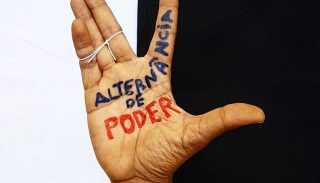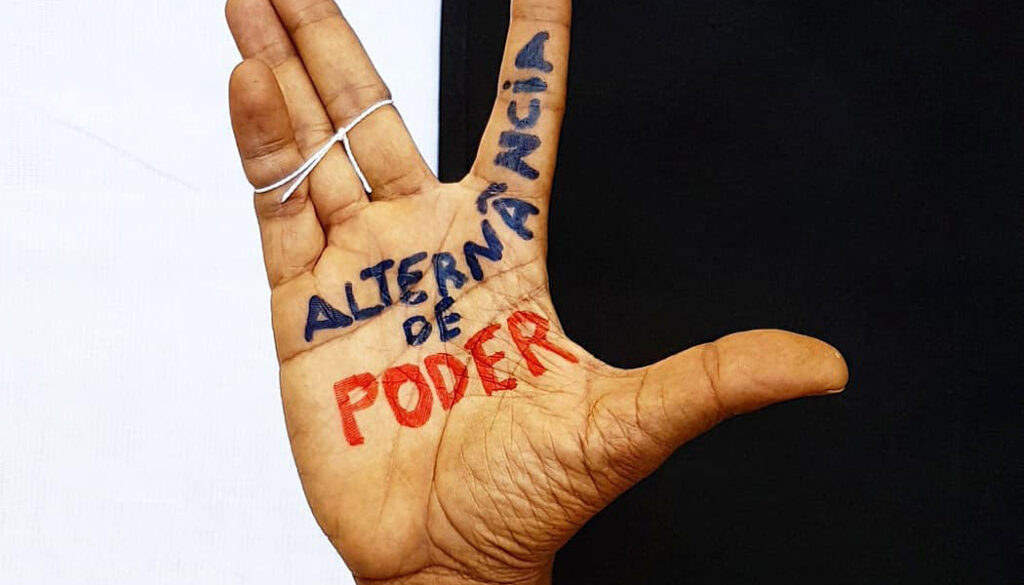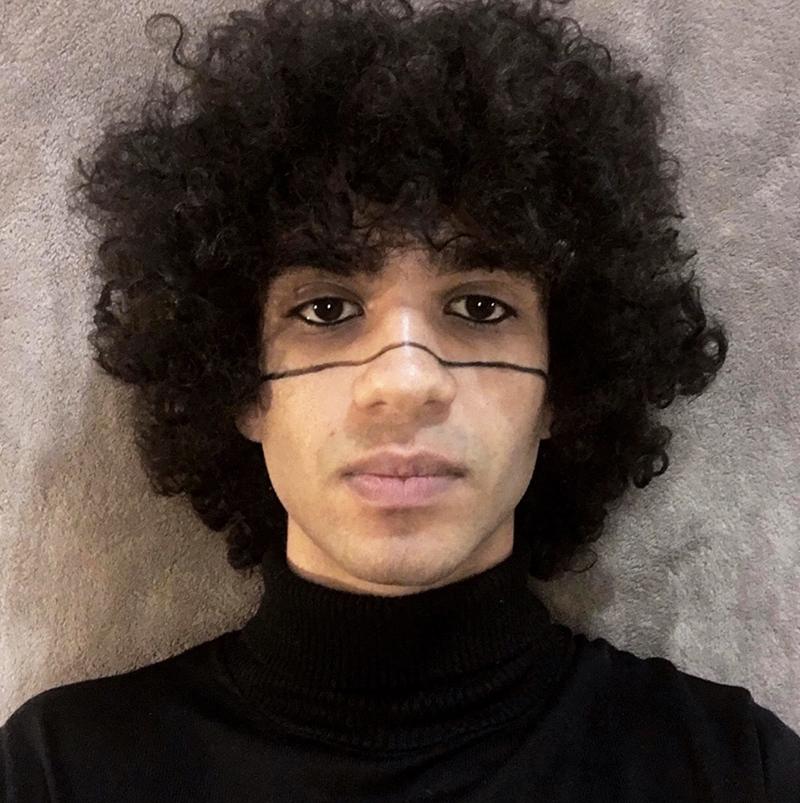
NEGRESTUDO: A MAPPING OF ARTISTS FEATURED IN SÃO PAULO’S ART GALLERIES
by Alan Ariê
October 8, 2020

Initial inspiration for Negrestudo (@negres.tudo)
Many debates around racial struggles have surfaced in the past two months, whether due to police violence, the abysmal difference in Covid-19 mortality rates between Black and non-Black people, or the subsequent visibility gained by Black public figures speaking on Blackness, after the internet was overtaken by self-proclaimed anti-racist movements. In the visual arts sector, we witnessed mass layoffs across numerous museums and institutions, disproportionately affecting Black staff members, further diminishing the already scarce presence of Black cultural workers. In response, we’ve seen an unprecedented surge in the visibility of diverse decolonial art practices, accompanied by virtual exhibitions, research aimed at generating institutional reparations, public questioning of the absence of Black artists selected in grant proposals, and discussion panels on the subject.

Alan Ariê, 24, works as an artist, curator, educator, researcher, and producer. Creator of the Negrestudo project, he is also featured in the Projeto Afro mapping initiative. Photo:Courtesy
In light of such a scenario of inequality in the arts, the Negrestudo project raises the following questions: What meaningful changes can be implemented within art institutions to promote racial reparation? Do Black, Indigenous, trans people and cisgender women enter museums only when their absence is being explicitly addressed? These reflections revealed the need to create a mapping project to explicitly show such inequity. In the initial phase, the art gallery market was chosen as the central focus. Both quantitative and qualitative data were gathered on all the artists featured in 24 art galleries in the city of São Paulo during the second semester of 2019 (the research was conducted between August and December). Some of the data may now be outdated, and the project remains open to dialogue with all of the galleries regarding potential updates to the data from the reference period.
Research methodology
As the central focus of this research, the list of artists represented by 24 art galleries in of São Paulo served as the primary data set, totaling 619 names organized into a set of tables: one containing information specific to each gallery alongside details about each artist; another with general data regarding place of birth; and a final table featuring the complete data on the artists from all 24 galleries. The first stage began in June 2019, when a spreadsheet was created and sent to the email addresses provided on the galleries’ respective websites, including the following items: name, gender, race, and place of birth of every artist represented. The galleries contacted were: Andrea Rehder, Baró Galeria, Casa Triângulo, Central Galeria, Dan Galeria, Galeria Fortes D’aloia e Gabriel, , Galeria Janaína Torres, Galeria Jaqueline Martins, Galeria Leme, Galeria Luciana Brito, Galeria Luís Maluf, Galeria Luisa Strina, Galeria Lume, Galeria Marcelo Guarnieri, Galeria Marília Razuk, Galeria Mendes Wood, Galeria Millan, Galeria Nara Roesler, Sé Galeria, SIM Galeria, Galeria Superfície, Galeria Vermelho, Galeria Kogan Amaro e Zipper Galeria. They were asked to complete the spreadsheet with data relevant to those artists featured in each of them.
Over the course of two weeks some emails were answered, after that a follow-up email was sent to the galleries that had not yet responded. Among the replies some galleries completed the spreadsheets as requested, others sent out an invitation for an in-person conversation (followed by the completion of the spreadsheet), while some refused to take part in the survey. The following galleries answered the survey: Lume, Marilia Razuk, Dan Galeria, Central Galeria, Baró, Superfície, Luis Maluf, Janaina Torres, Marcelo Guarnieri, and Jaqueline Martins. Those who refused to answer were Galeria Kogan Amaro and Galeria Leme. Galeria Nara Roesler replied saying they would collect the data, but never sent it. The remaining galleries never responded.
The second stage of the research— manual data collection—began once it became clear that some galleries would not return the completed spreadsheet. After identifying which artists were featured in each gallery, the researcher investigated the works, biography, images, and place of birth of each artist via their personal websites and that of the gallerie representing them. This method was used as it was the most efficient and, from it, conclusions were drawn about the gender and race of each artist. We acknowledge that there may be a minimal margin of error in the identification of each individual. It is also important to note that this manual collection was not conducted through self-identification, which is often considered (by many) a more accurate method in terms of cultural identity. However, in addition to understanding that applying this method in the context of the present research would have been both time consuming and possibly invasive, we also took into consideration the numerous recent episodes of fraud in admissions that required self-declaration by Black, Indigenous, and People of Color (BIPOC). Likewise, we do not know which of the galleries responding to the questionnaire sought individual self-identification from each of the artists they represent or whether they used another method to complete the spreadsheet. In these cases, we only have the word of the staff member who mediated the contact between the researcher and the information belonging to both the artists and the gallery.
After collecting and organizing all the data, the tables and their respective lists were created. For each gallery, the tables include numerical and percentage breakdowns by gender, race and place of birth of the artists, followed by a list of all variables combined. Based on total values obtained, the percentage of each group represented and/or absent was calculated.
The dissemination of this data was designed for various media platforms: infographics were produced and later published on an Instagram account created for the project. These same infographics were to be adapted into a zine format and distributed to all the art galleries mentioned in this research, as well as sent to a number of art museums in the city of São Paulo. However, due to the COVID-19 pandemic, we understood that it no longer made sense to proceed with the physical publication. One chart combines the data on race and gender; another illustrates racial disparity; another highlights overall gender disparity; an additional chart focuses on disparity according to place of birth; and additional charts cross-reference data across segments such as racial disparity among cis women or gender disparity among white people, etc. All the tables will remain available for free consultation on the web via link.
It is in our interest to illustrate the procedures used to structure this research as we do not intend to use any resources that might obscure or embellish them. The discourse constructed here does not claim to be a totalizing truth but rather reflects its processual character. While there is a scientific methodology guiding the construction of this project, there is also a true and objective engagement with the issues it addresses. Based on these tables, other artistic processes are already being developed, and I leave open the possibility for continued investigations into the same object of study. The project is planned so that, in its second edition, a website will be created to update this data on a biannual basis.
The art market and the exclusion of Black, Indigenous, and trans people
From the data collected, one can observe the extent of exclusion affecting certain groups within the professional arts circuit. However, it is clear that the most alarming issue is the predominance of white people. Of the 619 names identified in the research, only 46 people are non-white. Among them, 27 are Black – 23 men and only 4 women; 14 are Asian—9 men and 5 women; 4 are mixed-race (pardo) – all men; and only 1 person is Indigenous, in this case a Mexican artist named Mariana Castillo Deball, meaning there are no Indigenous people born in Brazil on the list.
It is also extremely important to note that there were no transgender people represented by the galleries at the time of data collection. Among the non-white groups, men already outnumber women, but this disparity becomes even more striking when we compare the general data: 426 cisgender men and 196 cisgender women. White women are the second-largest demographic, with 183 artists. The racial disparity among women is even more striking: the 4 cis Black women represent only 2.07% of all women, while the only Indigenous woman represents 0.51%. Among men, although the disparity is slightly smaller, it is still significant: cis Black men make up 5.39%, and there are no Indigenous men in São Paulo’s art galleries.
As for place of birth, it didn’t come as a surprise that São Paulo galleries feature more artists from their own city and state. What stands out is the number of European artists, who outnumber both those from any Brazilian region except for the Southeast, and those from every other continent; and the number of U.S. artists, which is surpassed only by the states of São Paulo, Rio de Janeiro, Minas Gerais, and Rio Grande do Sul, in addition to Argentina. The state of São Paulo features the most artists with 203 (32.79%), its capital city alone accounting for 153 (24.71%), while all other cities in the state combined account for 50 (8.07%). In Brazil, the Southeast region accounts for 326 (52.66%) artists, followed by the Northeast with 39 (6.30%), the South numbered 38 (6.13%), the Federal District 8 (1.29%), the North 7 (1.13%), and the Center-West 6 (0.96%). Outside Brazil, as mentioned earlier, the most represented continent is Europe, with 87 artists (14.05%), followed by South America with 53 (8.56%), North America 30 (4.84%), Asia 15 (2.42%), Central America 9 (1.45%), and Africa with only 1 artist (0.16%), the Nigerian Otobong Nkanga. Some Brazilian states were not represented by any artists in the galleries, these include: Acre – Amapá – Amazonas – Roraima – Rondônia – Tocantins – Piauí – Mato Grosso.
Below is a list of all the Black artists featured in the study:
Emanoel Araújo, Helô Sanvoy, Eneida Sanches, CL Salvaro, Camila Rocha, Nunca, Samuel de Saboia, Jaime Lauriano, Vini Parisi, Crânio, Marepe, Alvaro Barrington, Antonio Obá, Deyson Gilbert, Otobong Nkanga, Paulo Nazareth, Rubem Valentim, Sônia Gomes, Alexandre Arrechea, Isaac Julien, René Francisco, Dalton Paula e Rafael RG.
According to the Continuous National Household Sample Survey (Pnad Contínua) by IBGE in the second half of 2019, 57.05% of the Brazilian population is of African descent and the Black middle class has existed for over seven decades. This leads us to question the reasons behind such a stark underrepresentation of Black people in São Paulo’s gallery market. The survey also highlights that in recent years there has been a significant increase in the presence of BIPOC students at both public and private universities, which leads to a greater number of potential Black cultural professionals graduating from visual arts programs in Brazil—many of whom aim to pursue careers as artists. This increase has been encouraged by affirmative action policies that reserve openings for public school and BIPOC students, policies which only began taking shape in the early 2000s and have been further reinforced since the 2012 Law No. 12.711. This raises yet another question: are these Black students, who have gained access to university, being proportionally included in the job market and in the institutional art circuit after graduating?
Cisgender women? White, but numbering only a third as many as cis men. In 23 of the 24 galleries, there were more cis men than cis women. Only the Galeria Superfície showed gender parity, with 6 cis women and 6 cis men in its group. In all 24 galleries surveyed, there were more white cis women than Black cis women. More specifically: only 3 galleries featured Black cis women (2 at Mendes Wood, 1 at Andrea Rehder, and 1 at Kogan Amaro), and only 1 gallery featured an Indigenous woman (Mendes Wood). It is also important to note that white cis women outnumber Black cis men by a factor of eight (183 to 23). Below we list all the women represented by the galleries surveyed, with Black and Indigenous women in bold:
Andrea Cypriano, Katia Canton, Alessandra Rehder, Cristina Ataíde, Eneida Sanches, Rita Gaspar Vieira, Sandra Lapage, Tatiana Arzamasova (Integrante do grupo AES+F), Amanda Mei, Courtney Smith, Elena Damiani, Maria Lynch, Maria Nepomuceno, Zhanna Kadirova, Joana Vasconcelos, Juliana Cerqueira Leite, Manuela Ribadeneira, Maricia Xavier, Mariana Palma, Sandra Cinto, Vânia Mignone, Anna Israel, Gabriela Mureb, Gisele Camargo, Mariana Manhães, Simone Cupello, Laura Miranda, Raquel Kogan, Adriana Varejão, Agnieszka Kurant, Bárbara Wagner, Beatriz Milhazes, Erika Verzutti, Gerben Mulder, Jac Leirner, Janaina Tschape, Leda Catunda, Lucia Laguna, Marina Rheingantz, Marine Hugonnier, Sara Ramo, Sergej Jensen, Sarah Lannan (artista do duo Simon Evans™), Valeska Soares, Ana Mazzei, Charbel-joseph H. Boutros, Letícia Parente, Lydia Okumura, Maria Noujaim, Martha Araújo, Regina Vater, Viola Yesiltaç, Ana Vitória Mussi, Anaisa Franco, Amalia Giacomini, Denise Milan, Renata Egreja, Alice Shintani, Amelia Toledo, Ana Paula Oliveira, Ana Sario, Angélica Teuta, Flávia Ribeiro, Gabriela Machado, Gerty Saruê, Laura Vinci, LIUBA, Luciana Ohira, Mariannita Luzzati, Niobe Xandó, Paola Junqueira, Silvia Velludo, Sonia Andrade, Tomie Ohtake, Ana Dias Batista, Johanna Calle, Lucia Mindlin Loeb, Mabe Bethonico, Maria Laet, Mariana Serri, Raquel Garbelotti, Renata Tassinari, Ana Prata, Lenora de Barros, Regina Parra, Sandra Antunes Ramos, Tatiana Blass, Débora Bolsoni, Yasmin Guimarães, Betty Leirner, Neide Sá, Anna Costa e Silva, Guga Szabzon, Ana Maria Tavares, Carla Zaccagnini, Carmela Gross, Chiara Banfi, Clara Ianni, Claudia Andujar, Dora Longo Bahia, Gabriela Albergaria, Lia Chaia, Marilá Dardot, Motta (do duo Motta e Lima), Rosângela Rennó, Tania Candiani, Helena Martins-Costa, Kika Levy, Kitty Paranaguá, Luciana Magno, Marcia Thompson, Renata Pelegrini, Sandra Mazzini, Talitha Rossi, Camila Rocha, Estela Sokol, Isabelle Borges, Katia Salvany, Luisa Almeida, Marcia Pastore, Nazareth Pacheco, Patricia Carparelli, Paula Costa, Ana Elisa Egreja, Candida Höfer, Jessica Mein, Marcia de Moraes, Sandra Gamarra, Vivian Caccuri, Fabiana de Barros, Liliana Porter, Paula Garcia, Regina Silveira, Rochelle Costi, Gasediel, Marie Luce Nadal, Leonor Antunes, Fernanda Gomes, Magdalena Jitrik, Luisa Lambri, Laura Lima, Renata Lucas, Anna Maria Maiolino, Lygia Pape, Nicolás Paris, Marina Saleme, Clarissa Tossin, Anna Bella Geiger, Dadamaino, Francesca Woodman, Iulia Nistor, Kishio Suga, Letícia Ramos, Mariana Castillo Deball, Marina Perez Simão, Naufus Ramírez-Figueroa, Nina Canell, Otobong Nkanga, Paloma Bosquê, Patricia Leite, Sofia Borges, Solange Pessoa, Sonia Gomes, Alice Miceli, Berna Reale, Brígida Baltar, Cristina Canale, Karin Lambrecht, Laura Vinci, Lucia Koch, Melanie Smith, Virginia de Medeiros, Denise Alves-Rodrigues, Maria Montero, Rebecca Sharp, Eliane Prolik, Julia Kater, Juliana Stein, Lais Myrrha, Marina Weffort, Adriana Duque, Ana Holck, Camila Soato, Camille Kachani, Carolina Ponte, Celina Portella, Flávia Junqueira, Graciela Sacco, Janaina Mello Landini, Katia Maciel, Monica Piloni e Romy Pocztaruk.
The gallery with the lowest percentage of white cis men is Mendes Wood at 41.66%, with the highest percentage of Black cis men and Black cis women (13.88% and 5.55%, respectively). In contrast, the gallery with the highest percentage of white cis men is Galeria Luciana Brito, with 82.75%. The galleries not featuring any Black artists are: Baró – Casa Triângulo – Dan Galeria – Fortes D’Aloia e Gabriel – Lume – Marcelo Guarnieri – Marília Razuk – Millan – Superfície – Vermelho – Janaína Torres – Luciana Brito – SIM – Zipper.
In response to this data, which demonstrates such inequity within the circuit, artist Aline Motta, who is not represented by any gallery, points out that sometimes “the problem is the lack of vision and engagement of the agents themselves, who are mostly white men. At times I think they’re afraid of losing the spotlight and the prestige of dictating the rules of the game, even if that means that, years from now, they’ll be seen as the retrograde directors of a museum who prevented an entire generation’s career from flourishing. They have all the tools available to make the ‘diversity’ discourse truly practical. The question is whether they are willing to give up their already well-established positions and the belief that holding those positions is ‘merit”, based” the artist remarked.
Following the completion of this research project, Diáspora Galeria was inaugurated with its mission specifically aimed at questioning the underrepresentation of Black and Asian artists in the art market. Founder Alex Tso reflects on the current scenario: “We have to be careful not to think that this struggle is only a recent phenomenon. Many people think this is just a passing wave, a contemporary trend. This is a most serious mistake. (…) Even though major museums and even art galleries are including conversations about race and gender, we still need to examine the top of the production chain: who are the people in power? I believe the transformation process in the art market has already begun, and there’s no turning back. Now, beyond just the artists, we need curators, gallerists, critics, art dealers, collectors, educators, cultural agents and a whole production network that is also racialized—especially at management and decision-making positions. (…) The questions and discussions which arise around this topic, and which are gaining strength in contemporary art, will only create disruptive tension if we understand that protagonism must be comprehensive. It must come from racialized artists and cultural agents articulating and strengthening their networks, so they are no longer dependent on tokenistic concessions from a whiteness that still holds on – tightly – to the power and influence in the national Brazilian art scene,” he says.
To build effective change within Brazil’s visual arts circuit, the first step is for all agents to develop awareness of their own social position. From there, they must work towards the redistribution of privilege granted to white cis people, primarily men, and actively join the struggle for a less unequal society. Let it be clear that this struggle does not belong to racialized people only. It requires direct, ongoing, and sustained action from everyone. Whiteness can no longer stay solely confined to engaged discourse, remaining comfortably seated in its chair.
Table with the 24 art galleries, listing the name, gender, race, and place of birth of each artist here
Table with data on gender and race here
Table showing general birthplace here
Table showing birthplace by gallery here
Click here to learn more about the artist Alan Ariê in the Projeto Afro mapping.
